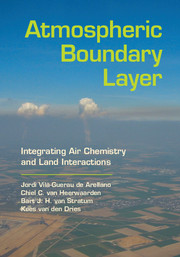Book contents
- Frontmatter
- Contents
- CLASS Software
- Preface
- Acknowledgments
- Part I The Land-Atmospheric Boundary Layer System
- Part II The Uncoupled System
- 2 Atmospheric Boundary Layer Dynamics
- 3 Atmospheric Boundary Layer Chemistry
- 4 Potential Temperature Budget: Diurnal Variation of Temperature
- 5 Moisture Budget: Diurnal Variation of Specific Moisture
- 6 Momentum Budget: Diurnal Variation of Wind
- 7 Scalar and CO2 Budget: Contributions of Surface, Entrainment, and Advection
- 8 Reactant Budget: Diurnal Variation of Ozone
- Part III The Coupled System
- Part IV Processes Related to Boundary Layer Clouds
- Part V User's Guide: CLASS Modules and Variables
- Appendices
- Bibliography
- Index
3 - Atmospheric Boundary Layer Chemistry
from Part II - The Uncoupled System
Published online by Cambridge University Press: 05 July 2015
- Frontmatter
- Contents
- CLASS Software
- Preface
- Acknowledgments
- Part I The Land-Atmospheric Boundary Layer System
- Part II The Uncoupled System
- 2 Atmospheric Boundary Layer Dynamics
- 3 Atmospheric Boundary Layer Chemistry
- 4 Potential Temperature Budget: Diurnal Variation of Temperature
- 5 Moisture Budget: Diurnal Variation of Specific Moisture
- 6 Momentum Budget: Diurnal Variation of Wind
- 7 Scalar and CO2 Budget: Contributions of Surface, Entrainment, and Advection
- 8 Reactant Budget: Diurnal Variation of Ozone
- Part III The Coupled System
- Part IV Processes Related to Boundary Layer Clouds
- Part V User's Guide: CLASS Modules and Variables
- Appendices
- Bibliography
- Index
Summary
We introduce the main characteristics of the chemistry system in the ABL. As with the dynamics, we explain the equations that govern the evolution of chemical species, emphasizing in particular their physical and chemical contributions to the diurnal variability of the reactive species, and providing a framework to understand and quantify how dynamic processes interact with the atmospheric reactivity.
Chemical Description
Several hundreds of species and reactions characterize the chemistry of the atmospheric boundary layer. As a buffer layer between the surface and the free troposphere, the ABL integrates the emission of chemically active species driven by soil processes or vegetation dynamics as well as their removal by dry and wet deposition processes. Within the dynamically evolving ABL upper region, air entrainment introduces air masses that may either enrich or dilute the chemically reactive species. The presence of ultraviolet radiation and turbulent mixing produces the right conditions for chemical transformations, turning the ABL into a dynamic reaction chamber in which secondary compounds are produced.
A useful method to classify the reactants is to relate them to the dynamic processes by defining the characteristic time-scales of reactions. Figure 3.1 shows some of the most relevant atmospheric components that are active in the lower troposphere. The diagram classifies them as a function of their characteristic reaction speeds and their horizontal spatial variability. This enables us to identify very rapid reactive species (radicals) whose time-scales are similar to those of the fast turbulent motions (<100 s). Particular attention should be paid to the hydroxyl radical (OH) because of its prominent role in oxidizing important hydrocarbon compounds such as methane (CH4), carbon monoxide (CO), and isoprene (C5H8). OH is therefore called the ‘atmospheric cleansing’ agent.
Important species such as O3 and isoprene react on a chemistry time-scale that is similar to the turbulent mixing under diurnal conditions (τ ≈ 15–30 minutes).
- Type
- Chapter
- Information
- Atmospheric Boundary LayerIntegrating Air Chemistry and Land Interactions, pp. 33 - 41Publisher: Cambridge University PressPrint publication year: 2015

